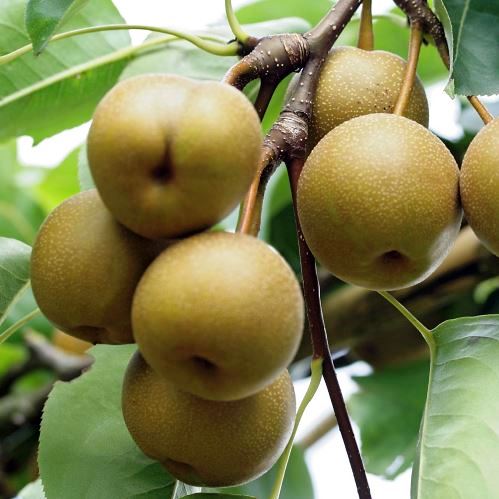Pyrus pyrifolia
NASHI-BIRNE
Englische Bezeichnung: Chinese Pear
Spanische Bezeichnung: Nashi
Familie
Rosengewächse (Rosaceae)
Verwendbare Teile:
Frucht
Hauptbestandteile:
Mineralstoffe: Kalium, Eisen, Magnesium, Phosphor
Vitamine: Vitamine C
Sekundäre Pflanzenstoffe: Flavonoide
Ernte-Hinweise:
Je nach Sorte färbt sich die Schale reifer Nashis gelblich oder rostbraun. Das Fruchtfleisch ist weiß-gelblich und gibt bei Druck etwas nach.
Verwendung:
Salate, Desserts
Die Bezeichnung Nashi-Birne ist eine Doppelung, denn Nashi ist das japanische Wort für Birne. Die Nashi-Birne wird treffend auch Apfelbirne genannt. Eine dünne, gelbgrüne Schale umhüllt die apfelförmige Frucht. Das saftige Fruchtfleisch ist knackig-körnig, wie beim Apfel und überrascht mit einem süß-säuerlichen Birnengeschmack. Im Inneren einer Nashi Birne befindet sich ein Kerngehäuse, wie wir es von heimischen Birnen und Äpfeln kennen
Family
Rose family (Rosaceae)
Usable parts:
Fruit
Main components:
Minerals: potassium, iron, magnesium, phosphorus
Vitamins: Vitamin C
Secondary plant substances: flavonoids
Harvesting guideline:
Depending on the variety, the skin of ripe nashis turns a yellowish or rusty brown colour. The flesh is white-yellowish in colour and yields slightly when pressed
Use:
Salads, desserts
The name nashi pear is a double meaning, as nashi is the Japanese word for pear. The Nashi pear is also aptly called an apple pear. A thin, yellow-green skin covers the apple-shaped fruit. The juicy flesh is crunchy and grainy, like an apple, and has a surprisingly sweet and sour pear flavour. Inside a Nashi pear is a core, as we know it from domestic pears and apples
Familia
Rosal (Rosaceae)
Partes utilizables:
Fruta
Componentes principales:
Minerales: potasio, hierro, magnesio, fósforo
Vitaminas: vitamina C
Sustancias vegetales secundarias: flavonoides
Guía de cosecha:
Dependiendo de la variedad, la piel de los nashis maduros adquiere un color amarillento o marrón oxidado. La pulpa es de color blanco amarillento y cede ligeramente al presionarla.
Uso:
Ensaladas, postres
El nombre de pera nashi tiene un doble significado, ya que nashi es la palabra japonesa para pera. La pera nashi también recibe el acertado nombre de pera manzana. Una fina piel verde amarillenta cubre la fruta en forma de manzana. La jugosa pulpa es crujiente y granulosa, como la de una manzana, y tiene un sorprendente sabor agridulce a pera. Dentro de una pera Nashi hay un corazón, tal como lo conocemos de las peras y manzanas domésticas.







































